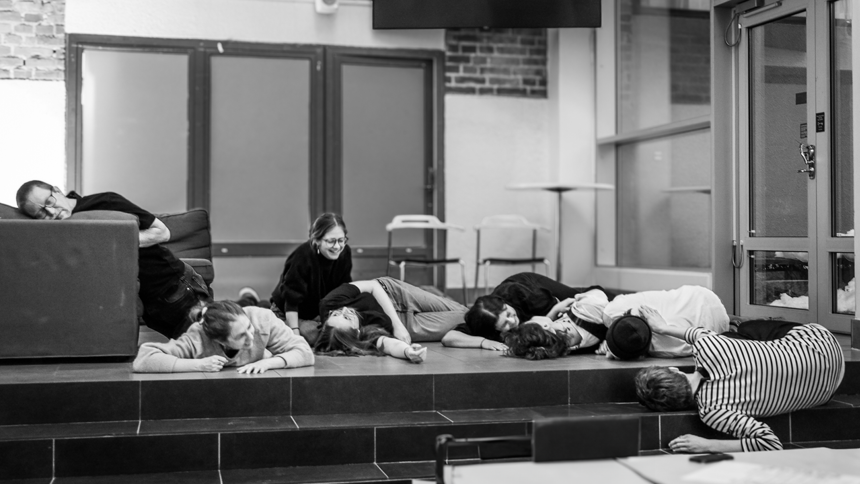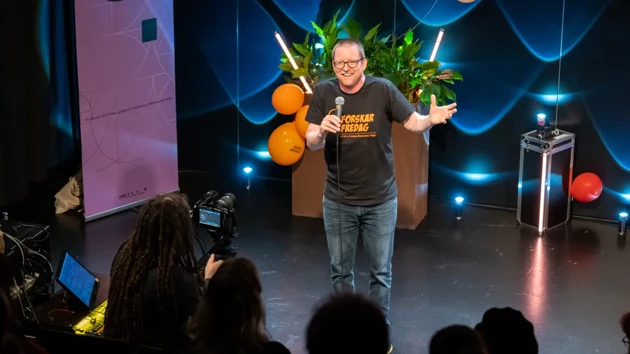Brendon Clark testing out stand up comedy during ForskarFredag, arranged by Umeå University.
The art of improvisation: Reimagining design education
How does one design for the unexpected interactions of everyday life? At Umeå institute of Design, Associate Professor Brendon Clark is pioneering an unconventional approach to design education, one that marries the spontaneity of improvisational theatre with the meticulous world of design. The method has boosted creativity among students through playful enactments of real-life events.

Associate Professor Brendon Clark and his students during a improv session in the main atrium at Umeå Institute of Design.
The somewhat unorthodox idea is not just about adding a fresh, creative twist to the curriculum; it’s about fundamentally rethinking how designers are trained to interact with the world around them. Clark’s philosophy is anchored in the notion that life itself is an improvisation.
“Everyday life is shaped by design, and in turn, we improvise to make sense of it. I want to arm students with the agility to navigate the unpredictable nature of real-world design challenges. The improv exercises allow them to engage in full-bodied activities that help them silence their inner critics”, says Brendon Clark.
A fusion of theatre and design
By weaving improv into the fabric of the education, Clark allows students to immerse themselves in authentic human experiences. Traditional design methods often rely on creating personas and hypothetical scenarios. Improv, however, thrusts students into role-playing exercises that mirror real-life interactions. This hands-on approach provides invaluable insights into how people might engage with their designs.
...improvisational exercises take design out of your head and puts it into action...
Brendon Clark underscores the importance of moving design from the abstract to the tangible.
“Truly improvisational exercises take design out of your head and puts it into action. By doing so, students can explore their design possibilities in a more realistic and playful manner, ultimately leading to more human-centred and effective outcomes”.
While previous design methods have drawn on theatre, such as experience prototyping and participatory design, Clark’s approach is unique in its comprehensive integration of improv techniques.
“We’re bringing a practice of how to teach and do improvisation from nothing, without a script, without even props. Our aim is the same though, to better understand users, stakeholders, interactions and situations”, says Brendon Clark.
Dynamic interactions
Clark highlights the unique contributions of guest teacher Rob Norman, author of the book, Improvising Now: A Practical guide to Modern Improv, whose organic style of improv focuses on the dynamics between people rather than just inventing ideas. This approach emphasises emotional and experiential connections, making it particularly effective in design contexts.

“It’s about working with the true interactions between people, and how you affect each other. This allows students to pressure test different types of scenarios”, says Clark.
The journey of integrating improv into design education is not without its challenges. While some embrace the opportunity for fun and creativity, others find it challenging. Clark acknowledges that it can draw on people’s insecurities, particularly the fear of performing or being in the spotlight. “It pokes on those insecurities a bit. However, it’s very invigorating when it works”, he says.
Improv beyond the classroom
The implications of this approach extend beyond the classroom. In the realm of research, Clark uses improv as a tool to probe new methodologies and stretch the boundaries of conventional design thinking. Him and his colleagues are disseminating their findings at various research seminars, illustrating how improv can be a potent tool in both design education and practice. One notable project involves using improv for language learning “in-the-wild” in Belgium, underscoring the method’s versatility and broad applicability.
The project, called “Language Learning in the Wild”, has been running for several for years, with the latest effort in a small city in Belgium. The idea is to turn everyday interactions into language learning opportunities. For example, language learners might visit a store, interact with staff, and then reflect on the experience to reinforce new vocabulary and concepts.

Brendon Clark's project, "Language Learning in the Wild", uses everyday interactions for language learning in Belgium, employing "improvised language games" to enhance language skills and confidence.
Another facet to this project involves “improvised language games”, designed to help learners make use of real-life interactions. These games involve tasks that require students to engage with their environment in an improvisational manner, using objects and scenarios to facilitate language practice. It transforms mundane activities into rich learning experiences. The approach not only enhances language skills but also builds confidence in navigating unfamiliar situations.
Clark sees the potential for improvisational theatre techniques to be applied in universities, schools, as well as workplaces. “The turn towards needing to do things together and create agreement quickly is increasingly important,” he says.
In a world where the only constant is change, the ability to improvise may just be the most valuable skill a designer can possess. At Umeå Institute of Design, that skill is already being honed by the next generation of designers.